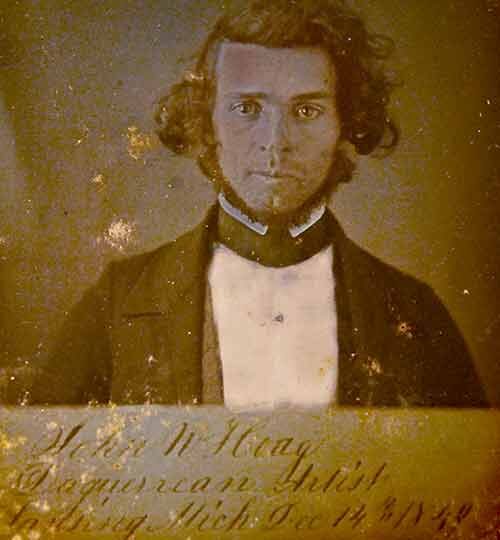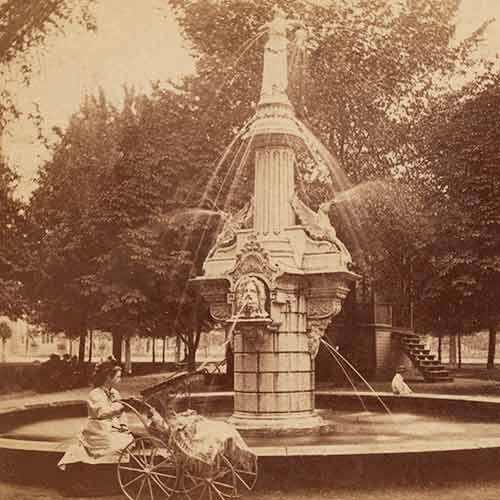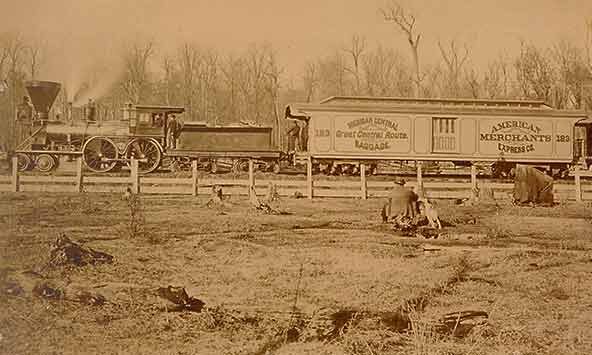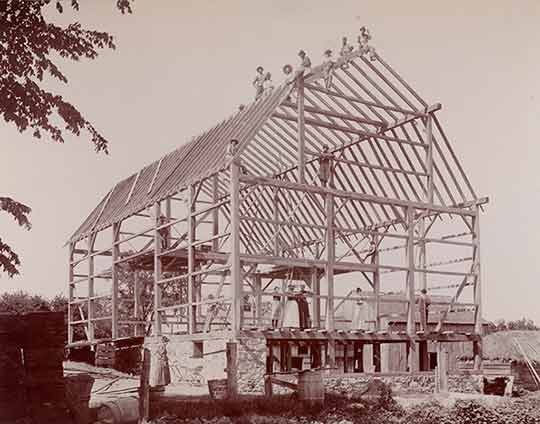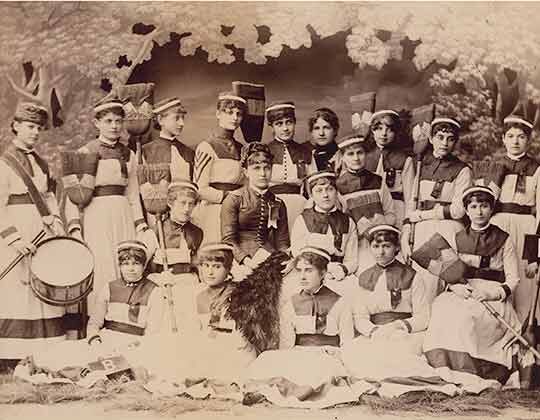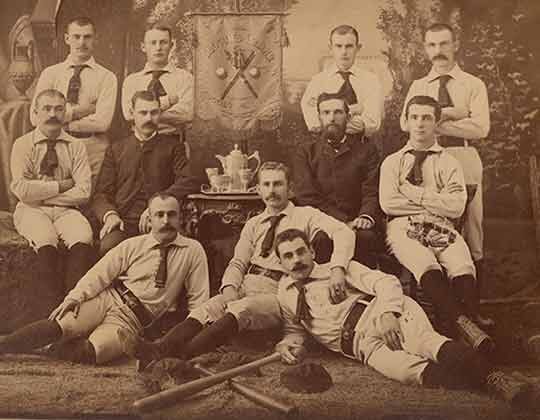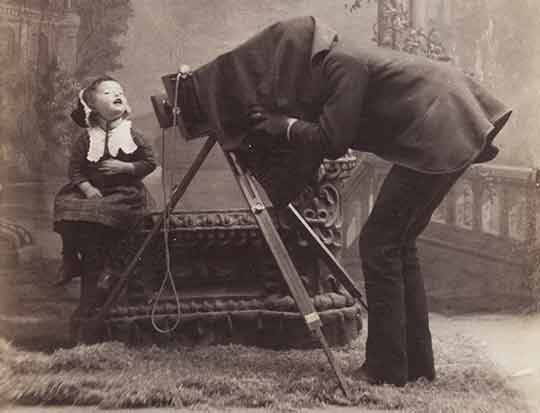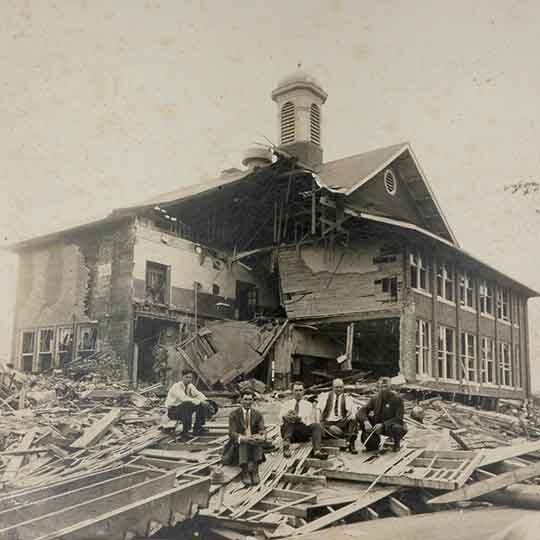Great Lakes, great photography
The David V. Tinder Collection of Michigan Photography, housed at the William L. Clements Library, offers virtually every photographic format used in the 19th and early 20th centuries: daguerreotypes, tintypes, stereographs, and more. The captions that accompany these select images were sourced from Tinder’s Directory of Early Michigan Photographers. Read more about this fascinating collection.
-
Royal T. Gillette, circa 1907
Format: Gelatin silver print by the Royal Photo Company. Royal Titus Gillette was an entrepreneurial photographer in the Grand Rapids area. He used several automobiles for both expanding his territory and promoting his business.
-
John W. Hoag, Lansing, Mich., 1849
Format: Daguerreotype. This self-portrait with sign-board indicates the sitter’s profession: “Daguerrean Artist.” Taken on Dec. 14, 1849, it is likely the earliest known portrait of a Michigan photographer.
-
John D. Appleton House, Brighton, Mich., circa 1850
Format: Daguerreotype by an unidentified artist. This Greek Revival-style house, built by carpenter John D. Appleton, still stands on Grand River Ave. in Brighton. The over-exposed portions of early daguerreotype plates naturally acquired a distinctive blue tint during development known as “solarization.”
-
U-M’s Detroit Observatory, Ann Arbor, circa 1858
Format: Salt print photograph by Thomas D. Tooker. University President Henry Tappan’s push to advance the University of Michigan as a research institution delivered one of the first observatories in the Midwest, built in 1854. It stands today, with its original telescopes. Tooker was on campus to photograph University students and faculty for class albums. According to historian Patricia Whitesell, the man in this photo may be the observatory director, Franz Brunnow, and the dog may be Tappan’s own Leo.
-
Fountain at Grand Circus Park, circa 1876
Format: Detail of a stereograph photo by James A. Jenney. Jenney was in the photographic business for more than 25 years, and his views of the booming lumber business and the city of Detroit were distributed by dozens of vendors across the state.
-
Michigan Central Train, circa 1866
Format: Albumen prints by the Cadwallader Brothers. Pulled by the locomotive Persian, this magnificent express train stopped west of Detroit for a posed panorama, made up from two plates. The photographer’s dark tent is likely in front of the baggage car. This is a cropped version of a much wider image.
-
Pictured Rocks: The Chapel, circa 1873
Format: Detail of a stereograph by Brainard F. Childs. Childs, who excelled at composing dramatic three-dimensional images, explored the Lake Superior region by land and water.
-
Ishpeming Miners, 1909
Format: Gelatin silver print by Childs Art Gallery. Founded in 1873 by Brainard F. Childs, the Childs Art Gallery remained active in the Upper Peninsula into the 1950s. This image captures surveying squad M.C.M. at Section 21 Mine, Ishpeming, Mich.
-
Cutting Down the Timber, circa 1880s
Format: Albumen print by an unidentified photographer. This image comes from a set of 16 prints documenting the removal of long-cut timber from old-growth forests in Alcona County.
-
Gallery and Residence of William Briley
Format: Cabinet photograph by William W. Briley studio, Flushing, Mich. The Briley family lived and worked in this house, converted in 1886 for the photography business. The large, north-facing skylight and window illuminates the interior studio space. Note the outdoor display case of samples on the side of the house.
-
Barn Raising, Dexter, circa 1893
Format: Gelatin silver print by Rupert Henry Scadin. There are at least 17 people, a baby carriage, and two United States flags involved in this common rural community ritual. Scadin worked in Michigan, North Carolina, and Massachusetts. His wife, Kate, hand-colored many of his monochrome photos.
-
Broom Brigade, circa 1880s
Format: Albumen print by an unidentified photographer. Broom brigades, organized much like drill teams, were a popular form of recreational exercise for young women in the 19th century. This particularly well-appointed group is likely from Ann Arbor.
-
Slocum’s Island Baseball Team, 1882
Format: Albumen print by an unidentified photographer. The silver tea set and banner are likely trophies won at a tournament on Slocum’s Island, now Elizabeth Park, near the city of Trenton, Mich. The dark-suited pair may be managers, leaving exactly nine players, one for each position.
-
Woodward Avenue, circa 1883-86
Format: Cyanotype by John Baldwin Thomas. Anticipating the atmospheric urban views of the New York Photo Secessionists, Thomas captures the raking afternoon sunlight highlighting the architectural details. The silhouetted carriage anchoring the foreground adds drama and mystery to the composition. An amateur photographer, Thomas was a professionally trained artist and lithographer working for the Calvert Lithograph Company of Detroit.
-
Portraiture in the Blair Studio, circa 1889
Format: Cabinet photograph. As a child, Wilson H. Blair migrated to Allegan County, Mich., from New York State with his parents, who began farming. After a 20-year career as a photographer in that area, Blair returned to New York State and to farming. This charming promotional image may be of Blair and his three-year-old daughter, Vera.
-
Royal Photo Company, circa 1907
Format: Gelatin silver print. Documentation of the back-room operations of early photographic studios is rare. That is Royal T. Gillette, himself, supervising with cigar in hand. Note the kitten assisting the bookkeeper on the left, and at right, across the desk, the hose from the camera’s squeeze-bulb emanating from Royal’s hidden right hand.
-
Burning the Mortgage of the Phyllis Wheatley Home, 1915
Format: Gelatin silver print by Harvey Cook Jackson. Although there were likely many African-American photographers working behind the scenes in 19th-century Detroit, it wasn’t until 1916 that an African-American, Harvey C. Jackson, opened a photographic business under his own name. Jackson’s shop was in the same location from 1916-40 and was prominent in documenting Detroit’s black community. The Phyllis Wheatley Home in Detroit was founded in 1897 to assist African-American women from the south establish careers in the north. This image was taken Jan. 4, 1915.
-
Bath School, after May 18, 1927
Format: Gelatin silver print, likely by Hiram Marple working for Leavenworth Photographic of Lansing, Mich. Local school board treasurer Andrew Kehoe, angry at the cost of the new Bath Consolidated School, dynamited the building while classes were in session, killing 44 people, including himself. Just before assaulting the school, Kehoe had killed his wife and set fire to his home. The Bath School Bombing of 1927 still stands as our nations’ deadliest school attack.
-
Automobile Works: Detroit, 1927
Format: Photogravure print by Emil Otto Hoppé. German born Hoppé, a pioneer of the modernist aesthetic in photography, was among the most famous photographers in Europe. Commissioned by publisher Orbis Terrarum, Hoppé traveled and photographed across the U.S. Large-scale industrial scenes like this view of the Ford Highland Park Plant were among his favorite subjects.
-
David W. Tinder
Dave Tinder’s collecting career has had many incarnations. Tiffany glass, Japanese metalwork, and antique ceramics have all had a place in his home. Inspired by William C. Darrah’s 1964 book, A History of Stereographs in America and Their Collection, he amassed a large number of international photographic stereo views. By the early 1970s he began trading his international collection for Michigan stereo views and commenced seriously collecting other early photographic formats related to Michigan subjects and photographers. Read more about the Tinder Collection. Photo by Laura McGuire, 2001.


